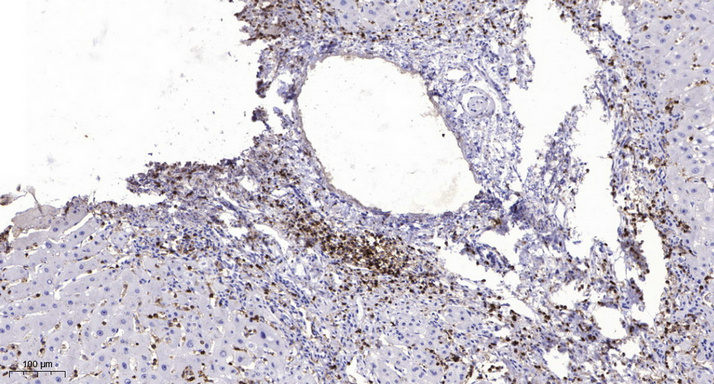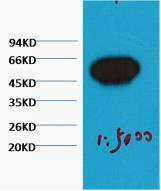MMP9 (Cleaved-Met94) rabbit pAb
- Catalog No.:YC0194
- Applications:WB;IHC
- Reactivity:Human;Rat;Mouse;
- Target:
- MMP-9
- Fields:
- >>Endocrine resistance;>>IL-17 signaling pathway;>>TNF signaling pathway;>>Leukocyte transendothelial migration;>>Estrogen signaling pathway;>>Relaxin signaling pathway;>>Hepatitis B;>>Pathways in cancer;>>Transcriptional misregulation in cancer;>>Proteoglycans in cancer;>>MicroRNAs in cancer;>>Prostate cancer;>>Bladder cancer;>>Diabetic cardiomyopathy;>>Lipid and atherosclerosis;>>Fluid shear stress and atherosclerosis
- Gene Name:
- MMP9 CLG4B
- Protein Name:
- MMP9 (Cleaved-Met94)
- Human Gene Id:
- 4318
- Human Swiss Prot No:
- P14780
- Mouse Gene Id:
- 17395
- Mouse Swiss Prot No:
- P41245
- Rat Gene Id:
- 81687
- Rat Swiss Prot No:
- P50282
- Immunogen:
- Synthesized peptide derived from human MMP9 (Cleaved-Met94)
- Specificity:
- This antibody detects endogenous levels of Human MMP9 (Cleaved-Met94, protein was cleaved amino acid sequence between 93-94 )
- Formulation:
- Liquid in PBS containing 50% glycerol, 0.5% BSA and 0.02% sodium azide.
- Source:
- Polyclonal, Rabbit,IgG
- Dilution:
- WB 1:500-2000;IHC 1:50-300
- Purification:
- The antibody was affinity-purified from rabbit serum by affinity-chromatography using specific immunogen.
- Concentration:
- 1 mg/ml
- Storage Stability:
- -15°C to -25°C/1 year(Do not lower than -25°C)
- Other Name:
- Matrix metalloproteinase-9 (MMP-9;EC 3.4.24.35;92 kDa gelatinase;92 kDa type IV collagenase;Gelatinase B;GELB) [Cleaved into: 67 kDa matrix metalloproteinase-9;82 kDa matrix metalloproteinase-9]
- Observed Band(KD):
- 68 78kD
- Background:
- catalytic activity:Cleavage of gelatin types I and V and collagen types IV and V.,cofactor:Binds 2 zinc ions per subunit.,cofactor:Binds 3 calcium ions per subunit.,disease:Defects in MMP9 may be a cause of susceptibility to lumbar disk herniation (LDH) [MIM:603932]. LDH is the predominant cause of low-back pain and unilateral leg pain.,domain:The conserved cysteine present in the cysteine-switch motif binds the catalytic zinc ion, thus inhibiting the enzyme. The dissociation of the cysteine from the zinc ion upon the activation-peptide release activates the enzyme.,enzyme regulation:Inhibited by histatin-3 1/24 (histatin-5).,function:May play an essential role in local proteolysis of the extracellular matrix and in leukocyte migration. Could play a role in bone osteoclastic resorption. Cleaves KiSS1 at a Gly-|-Leu bond. Cleaves type IV and type V collagen into large C-terminal three quarter fragments and shorter N-terminal one quarter fragments. Degrades fibronectin but not laminin or Pz-peptide.,induction:Activated by 4-aminophenylmercuric acetate and phorbol ester.,miscellaneous:In the arthritis patient this enzyme might contribute to the pathogenesis of joint destruction and might constitute a useful marker of disease status.,PTM:N- and O-glycosylated.,PTM:Processing of the precursor yields different active forms of 64, 67 and 82 kDa. Sequentially processing by MMP3 yields the 82 kDa matrix metalloproteinase-9.,similarity:Belongs to the peptidase M10A family.,similarity:Contains 3 fibronectin type-II domains.,similarity:Contains 4 hemopexin-like domains.,subunit:Exists as monomer, disulfide-linked homodimer, and as a heterodimer with a 25 kDa protein. Macrophages and transformed cell lines produce only the monomeric form.,tissue specificity:Produced by normal alveolar macrophages and granulocytes.,
- Function:
- skeletal system development, immune system development, leukocyte differentiation, myeloid leukocyte differentiation, proteolysis, regulation of cell death, positive regulation of cell death, hemopoiesis, myeloid cell differentiation, extracellular matrix organization, macrophage differentiation, regulation of cell migration, positive regulation of cell migration, collagen catabolic process, collagen metabolic process, regulation of locomotion, positive regulation of locomotion, regulation of apoptosis, extracellular structure organization, positive regulation of apoptosis,regulation of programmed cell death, positive regulation of programmed cell death, multicellular organismal metabolic process, multicellular organismal catabolic process, multicellular organismal macromolecule metabolic process,hemopoietic or lymphoid organ development, regulation of cell motion, positive regulation of
- Subcellular Location:
- Secreted, extracellular space, extracellular matrix .
- Expression:
- Detected in neutrophils (at protein level) (PubMed:7683678). Produced by normal alveolar macrophages and granulocytes.
- June 19-2018
- WESTERN IMMUNOBLOTTING PROTOCOL
- June 19-2018
- IMMUNOHISTOCHEMISTRY-PARAFFIN PROTOCOL
- June 19-2018
- IMMUNOFLUORESCENCE PROTOCOL
- September 08-2020
- FLOW-CYTOMEYRT-PROTOCOL
- May 20-2022
- Cell-Based ELISA│解您多样本WB检测之困扰
- July 13-2018
- CELL-BASED-ELISA-PROTOCOL-FOR-ACETYL-PROTEIN
- July 13-2018
- CELL-BASED-ELISA-PROTOCOL-FOR-PHOSPHO-PROTEIN
- July 13-2018
- Antibody-FAQs
- Products Images

- Immunohistochemical analysis of paraffin-embedded human liver cancer. 1, Antibody was diluted at 1:200(4° overnight). 2, Tris-EDTA,pH9.0 was used for antigen retrieval. 3,Secondary antibody was diluted at 1:200(room temperature, 45min).



